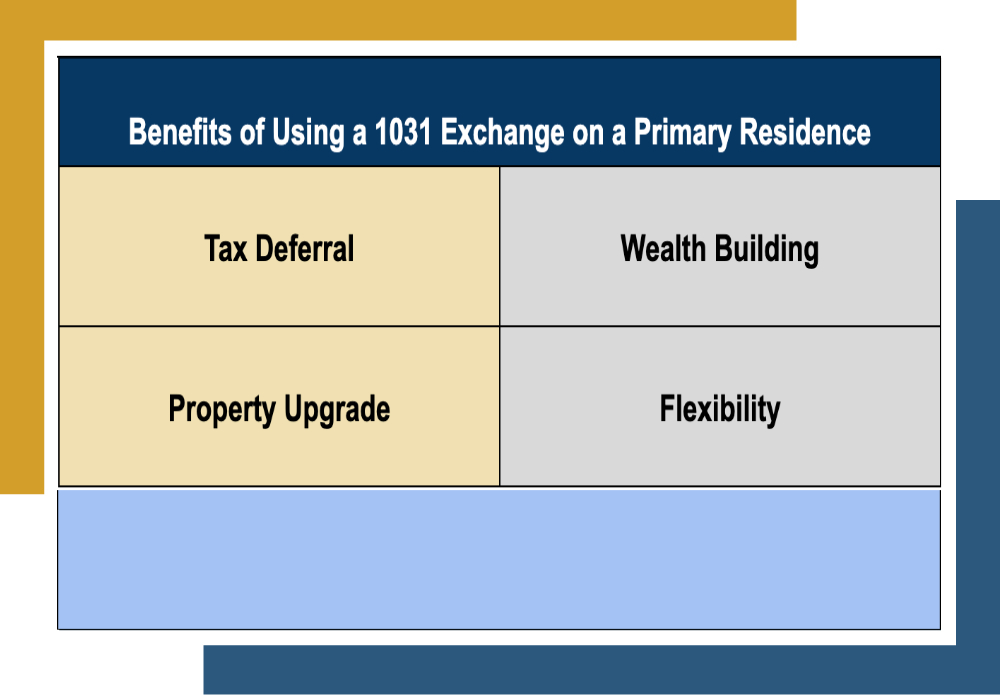Anyone who has managed or sold real estate properties is keenly aware of at least one of life’s few guarantees: taxes. Whether you make a record-breaking return or a modest profit, the Internal Revenue Service inevitably appears to collect the government’s cut.
Some savvy property owners use a 1031 exchange to delay capital gains taxes, typically restricted to investment properties. However, some wonder if a 1031 exchange can apply to a primary residence.
The IRS explicitly says “no,” but Section 1031 of the tax code has exceptions that may allow for a 1031 exchange on a primary residence. Below, I’ll explain the process and how it could be possible to use this fantastic tax deferral tool.
Using a 1031 Exchange on a Primary Residence
Usually, the IRS does not allow 1031 exchanges for primary residences. This factor is because 1031 exchanges are meant to be used on investment properties or properties held for business purposes, and primary residences are used as your shelter.
However, as with many things in the Internal Revenue Code, there are exceptions to the rule and ways to use a 1031 exchange for a primary residence.

Converting a Primary Residence Into an Investment Property
How often has someone mentioned they’ve decided to buy a new home and rent the old one to tenants? Perhaps you’ve even done this yourself, as it’s a typical entry path to real estate investing for many Americans.
One way you can conduct a 1031 exchange on your primary residence is by converting it into an investment property.
There are a couple of stipulations, of course:
- The IRS does not explicitly state how long a property must be held for rental purposes to be used for a 1031 exchange. A general rule of thumb, upon which many CPAs agree, is that you should rent the property out at fair market rates for at least two years.
- You cannot reside at your property in any capacity while it’s being used as a rental. It must be explicitly used for investment purposes.
|
How to Convert a Primary Residence into an Investment Property for a 1031 Exchange |
|
|---|---|
| 1. Move Out of the Primary Residence |
First, you must vacate the premises and stop using it as a primary residence. |
| 2. List the Property for Rent |
You will then need to rent out the property (at fair market value). This step is crucial because it establishes that the property is being used for investment purposes and no longer serves as your primary residence. |
| 3. Rent the Property for at Least Two Years |
While the IRS doesn’t set a specific timeframe, it’s widely recommended that the property be rented for at least two years to clearly establish it as an investment property for tax purposes. |
| 4. Do Not Reside in the Property |
While the property is being rented, you cannot live in it. The property must be used exclusively for investment purposes. |
| 5. Document Rental Income and Expenses |
Keep accurate records of all rental income and expenses, such as maintenance, repairs, and property management. Doing so will support the conversion in case of an IRS audit. |
| 6. Conduct a 1031 Exchange |
After holding the property for investment purposes, you may now be eligible to use a 1031 exchange to defer capital gains taxes when selling the property and purchasing another investment property. |
Here’s a hypothetical example of this process. John lived in his home for 10 years but decided to rent it out when he moved to a new house. After renting it at fair market value for two years, he converted it into an investment property.
By following IRS guidelines, he was able to use a 1031 exchange on his former primary residence, deferring capital gains taxes and rolling the proceeds into a new investment property.
Section 121 Exclusion
Another option for saving taxes is to exclude part of the capital gain using a Section 121 exclusion. While not quite the same as a 1031 exchange, Section 121 exclusions can give you additional elbow room for capital gains taxes on primary residences.
Instead of being a method of tax deferral, it allows you to exclude gains on the sale of a primary residence of up to $250,000 for single filers and $500,000 for joint filers. To use Section 121, you must have resided on the property for at least two of the previous five years, although it doesn’t have to be a continuous period.
There is one huge caveat with Section 121 exclusions. Homeowners can only claim this exclusion once every two years.
|
Section 121 Breakdown |
|
|---|---|
| 1. Understand Section 121 Exclusions |
Section 121 allows homeowners to exclude up to $250,000 (single filer) or $500,000 (joint filer) of capital gains on the sale of a primary residence. |
| 2. Meet Residency Requirements |
You must have lived in the home as your primary residence for at least two of the five years before the sale. These two years do not need to be consecutive. |
| 3. Claim the Exclusion |
Homeowners can claim the exclusion once every two years, meaning they can use it repeatedly so long as the conditions are met. |
| 4. Mixed-Use Properties |
If the property was partly used as a primary residence and partly for investment, you may still qualify for a partial exclusion based on the percentage of time that it served as a primary residence. |
| 5. Consider Special Circumstances |
Exceptions exist for special situations, such as unforeseen circumstances (job change, health reasons), which may allow for a partial exclusion even if the residency requirement isn’t fully met. |
It should be noted that any tax strategy involves adherence to rigid guidelines to ensure validity. Always consult with a tax professional or financial advisor before making any decisions regarding your property.
Canyon View Capital Makes 1031 Exchanges Easy
Now that you know more about using a 1031 exchange on a primary residence, you’ll be looking for options to use a 1031 exchange. If you’re one of the many investors who no longer want to carry the burden of property management or simply want an easier way to receive real estate income. CVC may have a great solution.
We manage a portfolio of multifamily properties across the Midsouth and Midwest valued at over $1 billion1, and we want to help you get a slice of that pie. By exchanging into one or more of our properties as Tenants in Common, you’ll be able to enjoy passive real estate income and potential tax benefits without lifting a finger.
Need more information on using a 1031 exchange on a primary residence?
Canyon View Capital can show you the way! We will walk you through every step of your 1031 exchange, and our in-house professionals will always answer your questions honestly, completely, and promptly. CVC will help you cut through the red tape, no matter how sticky it gets. Contact Canyon View Capital TODAY!
Verified accreditation status required.
Gary Rauscher, President
When Gary joined CVC in 2007, he brought more than a decade of in-depth accounting and tax experience, first as a CPA, and later as the CFO for a venture capital fund. As President, Gary manages all property refinances, acquisitions, and dispositions. He works directly with banks, brokers, attorneys, and lenders to ensure a successful close for each CVC property. His knowledge of our funds’ complexity makes him a respected executive sounding board and an invaluable financial advisor.


